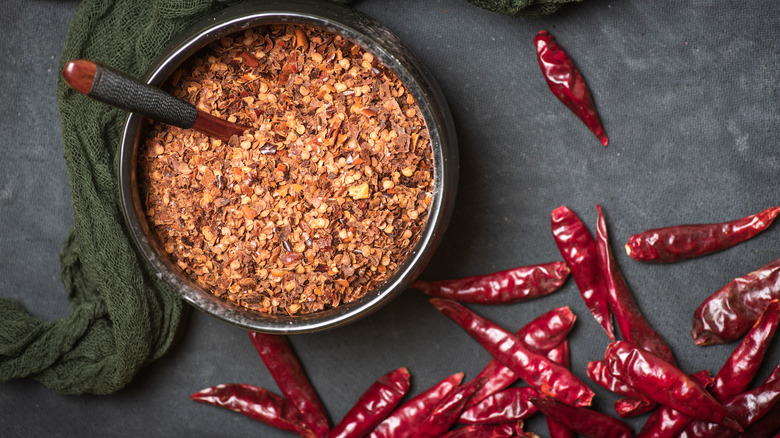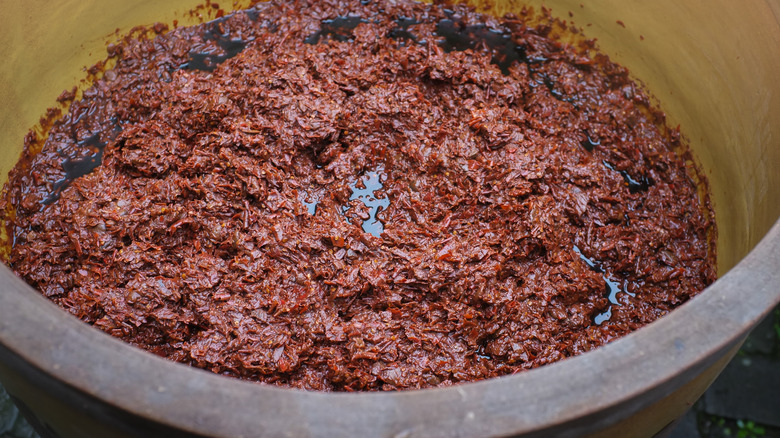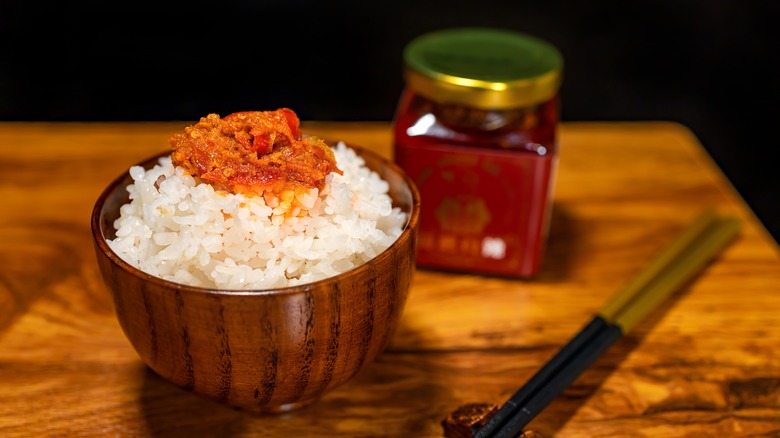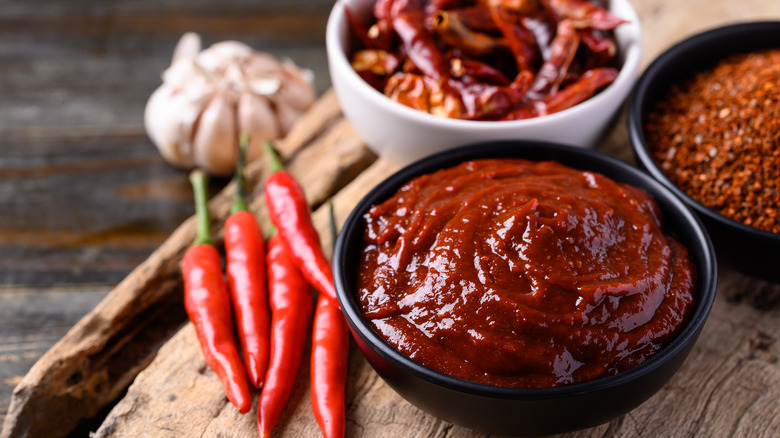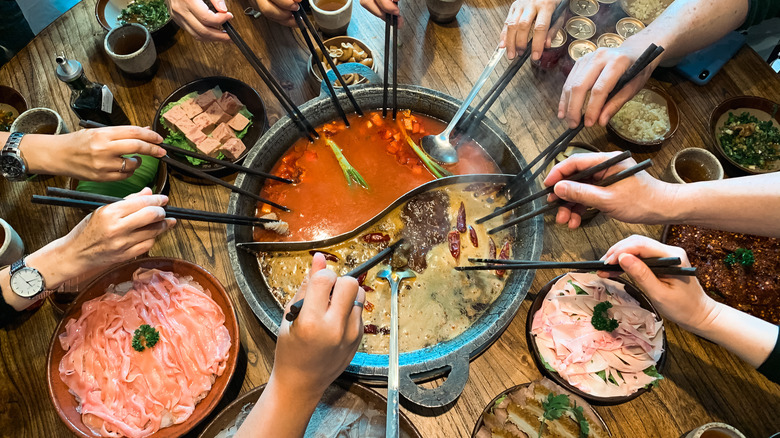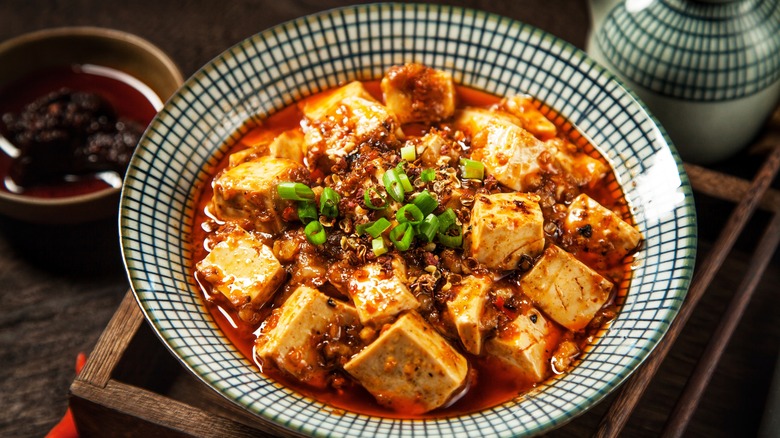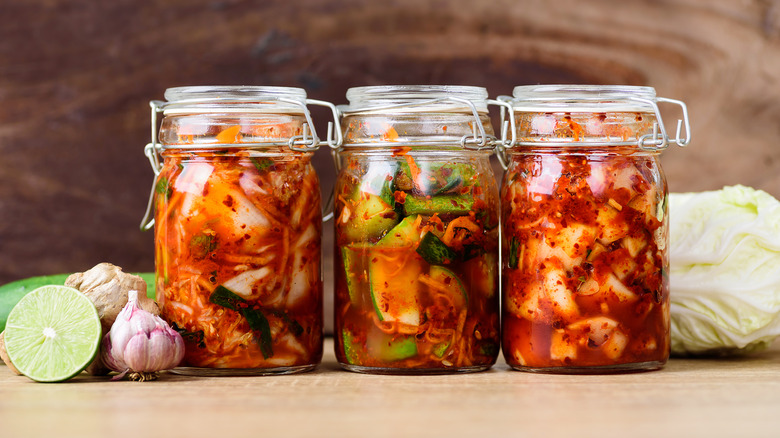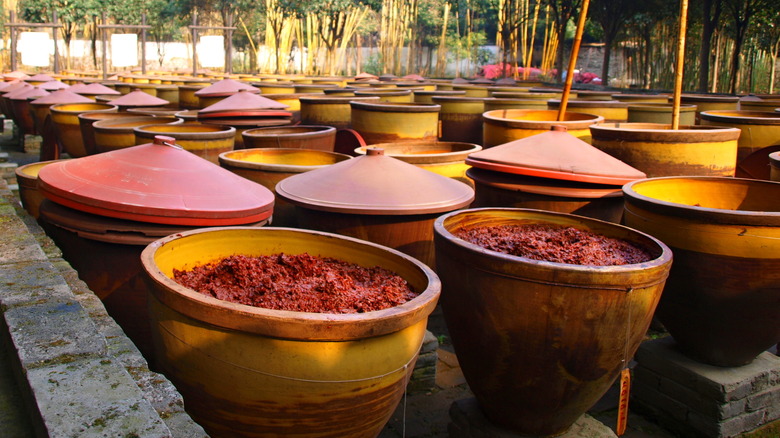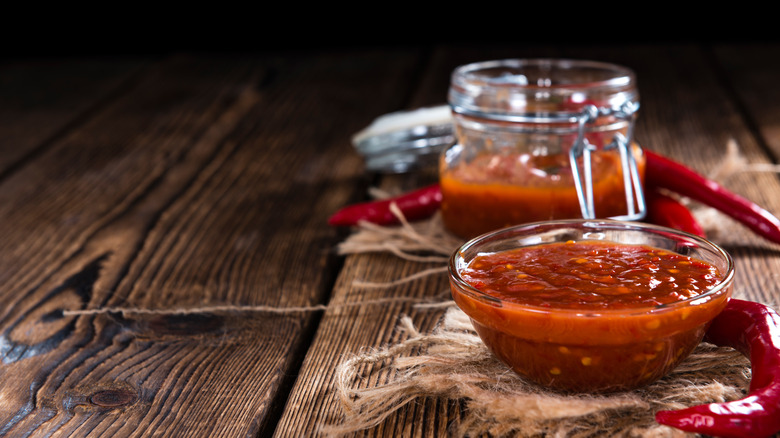Doubanjiang Is The Chinese Staple You Should Know
If you love Chinese food as much as we do, specifically Sichuan food, you'll want to pay attention as this guide walks you through one of this popular cuisine's key ingredients. Doubanjiang, or spicy bean sauce, is a Chinese food staple most commonly seen in Sichuan dishes – often known for their sizzling flavors. Chinese food can be quite complex, incorporating ingredients from each of its many regions. As with many of the popular ingredients incorporated in Chinese cuisine, doubanjiang has a varied history that has since branched out from its origins in the town of Pixian in Chengdu. Luckily, we're here to give you all of the fine details of this heavily used and well-loved ingredient — from its history, to how it's made, and everything in between.
If you frequent your local Chinese takeout spot or are a fan of Sichuan-style Chinese restaurants, there is a good chance you've had doubanjiang and didn't even know it. In fact, it's so prevalent in Sichuan cooking that many refer to doubanjiang as "the soul of Sichuan cooking." Whether you're looking to recreate popular Sichuan dishes at home, or are simply curious about the secrets to popular dishes from the region, you'll find all the answers to your questions here. From a mix of information from home recipe guides and expert opinions, we've created a comprehensive guide to all things doubanjiang as we break down why this ingredient should be a staple in your kitchen.
What is doubanjiang?
Before we dive in any further, let's talk about what doubanjiang actually is. This dark, textured paste is made from broad beans, chili peppers, salt, and wheat flour. You may also see it in recipes or stores as spicy broad bean paste, broad bean chili sauce, or tobanjiang. While there are many names for doubanjiang, the most important thing that makes it so iconic is the chilis to give the paste its iconic punch of flavor — specifically erjingtiao chilis.
Doubanjiang originates from the Chinese town of Pixian in the providence of Sichuan, where Chinese cooking experts say you'll find the best doubanjiang. The most authentic versions of this popular ingredient are still made in its birthplace, where the fermentation method involves placing the soybeans under direct sunlight for the best results. Prior to mixing, the broad beans are left to ferment, which allows the flavor to develop over time. The longer that this integral ingredient can ferment the better, with some jars left to ferment for as long as three years.
Doubanjiang is distinguishable for its bright reddish-brown color, and its chunky texture which sets it apart from otherwise smoother pastes. The darker the color of the bean paste, the longer it has been left to ferment.
What does doubanjiang taste like?
Different kinds of fermented pastes are quite common in Asian cooking, but each can be distinct in flavor, texture, and color. Doubanjiang's taste is uniquely known for its rich umami flavor, which is developed throughout the aforementioned fermentation process.
A maximized fermentation period is critical to this paste developing its distinctly intense umami taste. Due to it being a highly concentrated paste, doubanjiang is known to be on the saltier side — which may be a conservative way of describing it. If cooking with doubanjiang, keep this in mind as the addition of salt and other seasonings should be done carefully, or not at all depending on the dish. The addition of this salty bean paste also means you should avoid using other salty condiments that might be commonly used to pair with Chinese cooking, such as soy sauce.
In addition to its umami flavor, the chili peppers can give doubanjiang a bit of a spicy kick. In Sichuan cuisine, spicier flavors tend to dominate the profile of most dishes. We've all found ourselves gulping down water and reaching for the tissues after a particularly spicy dish, but the perk of home cooking is the ability to control the level of heat. If you're looking for a version of this staple ingredient that won't have your nose running profusely, there is a standard doubanjiang that has omitted the chili peppers – just double-check which version you're buying at the store.
Doubanjiang versus gochujang
You may be familiar with gochujang, the commonly used chili paste that dominates Korean food cooking. With chili-based pastes and sauces being popular ingredients in Asian cuisine, gochujang is often conflated with doubanjiang. While the two are similar in their uses and ingredients, they are very distinct when broken down.
Gochujang is also a fermented paste, formed from a combination of glutinous rice, fermented soybeans, chili flakes, and salt. This delicious paste is used in Korean cooking in a variety of ways, similar to the use of doubanjiang in Sichuan cooking. In a similar way, gochujang is extremely versatile and can be used in a range of dishes from stir fry, to stews and soups, and as a marinade for many meats. However, the flavor profiles of these two pastes are very different.
Gochujang is described as having a tangier and sweeter taste despite how much heat it can add to a dish, whereas doubanjiang is known for being salt-forward. The added sweetener in gochujang also makes it heat faster than doubanjiang, which is worth noting when cooking with either paste. Doubanjiang is unique from many chili pastes with its texture, which is much less smooth. The last stark difference between these two is their uses, as many are quick to suggest gochujang as a doubanjiang substitute. Gochujang is much more palatable as a standalone and is often used as a table condiment, whereas doubanjiang needs flavors from other ingredients to balance it out.
How is doubanjiang used?
As the soul of Sichuan cooking, one might safely assume that doubanjiang is used in most Sichuan dishes. Sichuan cooking expert, Jing Gao, highlights that the best part of this ingredient is its versatility — making it easy to add to any dish for a wave of flavor. One of the most popular dishes in Chinese cooking that incorporates doubanjiang is mapo tofu. While there are many things that make this dish delicious, doubanjiang is truly the foundation — as with many others. In traditional Sichuan cooking, this dish is known to be particularly mouth-numbing but is delicious nonetheless.
For fans of hot pot, which originates from Chinese cuisine, doubanjiang is another staple ingredient for this experience. Many Chinese hot-pot restaurants will offer a Sichuan soup base that uses, you guessed it, doubanjiang to give the broth its stand-out red coloring. Other popular dishes where doubanjiang is a critical ingredient include kung pao chicken and twice-cooked pork.
While there are a number of popular recipes that can be recreated using doubanjiang, as mentioned before, it's easy to add to any dish without a recipe. Something as simple as a stir fry can be quickly elevated with the addition of this delicious bean paste. Other ways where you may freestyle with doubanjiang are by using it as a side. Mix the bean paste with other liquids and sauces to create a tasty dipping sauce, or get creative and make a marinade for any meat of your choosing.
How to cook with doubanjiang
In most dishes that commonly use doubanjiang for flavoring, the paste is added to heated oil in a pan before any other ingredients are added. If using a spicy doubanjiang, this allows for the heat to release which creates a chili-oil-like substance to be absorbed by the rest of the dish. If using doubanjiang in something like a stir fry, this method of adding it to the heated pan is the best way of using it to create a sauce meant to be soaked up by other additions such as meat and vegetables.
Given its salty flavor profile, it's critical that when cooking with doubanjiang, you incorporate other ingredients so that the saltiness doesn't overpower the rest of your dish. This is why with most recipes that use doubanjiang, you'll see that other things such as ginger, garlic, and stock are used. Using vegetables that can soak up the flavor of the fermented bean paste and balance it out is also wise; common examples include eggplant, bok choy, or broccoli. A little bit goes a long way with doubanjiang, and something as small as a tablespoon can be enough to flavor an entire dish.
If using doubanjiang as a marinade, consider mixing it with a dash of rice vinegar and some sugar. Both of these ingredients will cut through the saltiness of the bean paste, creating a well-balanced sauce to coat any type of meat and pack it with flavor.
Nutritional information and health benefits
Aside from the fact that this spicy bean paste may clear your sinuses out, it does have other nutritional information and health benefits that are worth mentioning. Given its high salt content, we wouldn't recommend incorporating this in high levels to your meals for both taste and health purposes. However, when consumed in moderation, doubanjiang can have some sneaky health benefits that may surprise you.
Doubanjiang includes small amounts of vitamin A in each serving and also provides some amounts of iron and calcium. It might not be enough to meet your daily intake of vitamins and minerals, but it certainly isn't nothing. As with most fermented foods, doubanjiang can also be a source of antioxidants with its base of fermented soybeans.
Recent trends in nutritional health have gone above and beyond to highlight the importance of gut health, with fermented foods being one of the core ingredients used to improve the health of your digestive system. These foods include things like kimchi, sauerkraut, and other notoriously pungent ingredients as they can help reduce inflammation. Incorporating fermented foods into meals daily, in small doses, is a relatively simple way of addressing certain health concerns. Luckily, a little bit goes a long way with doubanjiang, so think of it as a small dose of gut health with your meal.
Where to buy doubanjiang
If you're wondering if it's possible to make this paste at home, given the simple line-up of ingredients, it's advised to buy one of the many options available in stores given the complex nature of this paste's fermentation process. As with most things, there can be quite an array of brands to choose from when it comes to buying doubanjiang for your pantry at home. While any old selection might do the job, we're here to advise on the most authentic selections that are available for purchase in the U.S.
Your best bet at finding authentic doubanjiang is at a local Asian grocery store, but many brands can also be found on Amazon. While these doubanjiang brands that are popular in America will work for a dish, experts advise that for a more authentic version, finding a paste that is labeled as Pixian broad bean paste is best. The Pixian region is known for specializing in the iconic spiciness that is commonly associated with Sichuan cooking, where other brands may make sauces catered towards more Cantonese cooking.
Other things to steer away from when looking for a doubanjiang in stores are unnecessary ingredients. Aside from the four basic ingredients, there isn't any reason for things like MSG or other additives. Additionally, look for brands that state fermentation time — those with years-long fermentation time will only enhance the dish more and may also be slightly more expensive.
Doubanjiang substitutes
If you can't get your hands on a store-bought doubanjiang, don't worry — there are plenty of alternatives to this commonly used ingredient that will do the job. For an easy at-home substitution, you can mix together a regular bean paste with either chili paste or chili oil to make a pseudo-spicy bean paste that mimics doubanjiang. Regular bean paste alone can also be used if you are looking to omit heat altogether. Chances are, you might already have these ingredients in your armoire. If that isn't the case and you find yourself scrapping pieces together, oyster sauce or miso paste can also be used in lieu of bean paste.
It shouldn't be a surprise that other Asian cuisines also commonly use versions of a chili bean paste that are closely related to doubanjiang. One such paste is sambal oelek, which is a Thai chili sauce that has a similar flavor profile to doubanjiang. This popular chili paste is used as a catch-all for many chili paste substitutions and can be used to spice up plenty of dishes – Thai or not. If the paste isn't spicy enough on its own, you can always add chili flakes or chili powder on your own to increase the heat.
